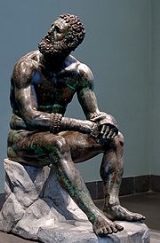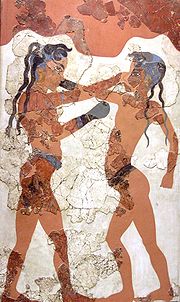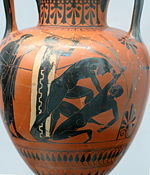
Ancient Greek Boxing
Encyclopedia
Ancient Greek boxing dates back to at least the eighth century BC (Homer's
Iliad
), and was practiced in a variety of social contexts in different Greek city-states. Most extant sources about ancient Greek boxing
are fragmentary or legendary, making it difficult to reconstruct the rules, customs and history surrounding this activity in great detail. Still, it is clear that gloved boxing bouts were a significant part of ancient Greek athletic culture throughout the early classical period.
 There is archeological and artistic evidence of ancient Greek boxing (πύξ - pux or πυμή - pugme in Αncient Greek) as early as the Minoan
There is archeological and artistic evidence of ancient Greek boxing (πύξ - pux or πυμή - pugme in Αncient Greek) as early as the Minoan
and Mycenaean
periods. There are numerous legends about the origins of boxing in Greece
. One legend holds that the heroic ruler Theseus
invented a form of boxing in which two men sat face to face and beat each other with their fists until one of them was killed. In time, the boxers began to fight while standing and wearing gloves (with spikes) and wrappings on their arms below the elbows, but otherwise they fought naked.
According to the Iliad, Mycenaean warriors included boxing among their competitions honoring the fallen, though it is possible that the Homeric epics reflect later Greek culture. Boxing was among the contests held in memorial of Achilles
' slain friend Patroclus, toward the end of the Trojan war. It was in commemoration of Patroclus that the Greeks later introduced boxing (pygme / pygmachia) to the Olympic Games in 688 BC. Participants trained on punching bags (called a korykos). Fighters wore leather straps (called himantes) over their hands (leaving the fingers free), wrists, and sometimes breast, to protect themselves from injury. There was no protection for the face or head.
The scholar and historian Philostratus
maintained that boxing was originally developed in Sparta
, in order to harden warriors’ faces for battle. The early Spartans believed helmets were unnecessary and boxing prepared them for the inevitable blows to the head they would receive in battle. However, Spartans never participated in the competitive aspect of boxing, believing the means of defeat to be dishonorable.
 Until around 500 BC himantes were used as protection for the knuckles and hand. They were thongs of ox hide approximately 3 to 3.7 meters long that were wrapped around the hands and knuckles numerous times.
Until around 500 BC himantes were used as protection for the knuckles and hand. They were thongs of ox hide approximately 3 to 3.7 meters long that were wrapped around the hands and knuckles numerous times.
In around 400 BC sphairai were introduced. The sphairai were very similar to himantes. The only notable difference was that they contained a padded interior when wrapped around the hands and the exterior of the thong was notably more rigid and hard.
Soon after the implementation of the sphairai, the oxys were introduced to boxing. They consisted of several thick leather bands encircling the hand, wrist, and forearm. A band of fleece was placed on the forearm to wipe away sweat. Leather braces extended up the forearm to give greater support when punching and the knuckles were reinforced with leather as well.
Korykos were the equivalent to modern punching bags. They were used for practice in the Palaestra
and were filled with sand, flour, or millet
.
 The currently accepted rules of ancient Greek boxing are based on historical references and images. Because of the few intact sources and references to the sport, the rules can only be inferred.
The currently accepted rules of ancient Greek boxing are based on historical references and images. Because of the few intact sources and references to the sport, the rules can only be inferred.
Homer
In the Western classical tradition Homer , is the author of the Iliad and the Odyssey, and is revered as the greatest ancient Greek epic poet. These epics lie at the beginning of the Western canon of literature, and have had an enormous influence on the history of literature.When he lived is...
Iliad
Iliad
The Iliad is an epic poem in dactylic hexameters, traditionally attributed to Homer. Set during the Trojan War, the ten-year siege of the city of Troy by a coalition of Greek states, it tells of the battles and events during the weeks of a quarrel between King Agamemnon and the warrior Achilles...
), and was practiced in a variety of social contexts in different Greek city-states. Most extant sources about ancient Greek boxing
Boxing
Boxing, also called pugilism, is a combat sport in which two people fight each other using their fists. Boxing is supervised by a referee over a series of between one to three minute intervals called rounds...
are fragmentary or legendary, making it difficult to reconstruct the rules, customs and history surrounding this activity in great detail. Still, it is clear that gloved boxing bouts were a significant part of ancient Greek athletic culture throughout the early classical period.
Origins

Minoan civilization
The Minoan civilization was a Bronze Age civilization that arose on the island of Crete and flourished from approximately the 27th century BC to the 15th century BC. It was rediscovered at the beginning of the 20th century through the work of the British archaeologist Arthur Evans...
and Mycenaean
Mycenaean Greece
Mycenaean Greece was a cultural period of Bronze Age Greece taking its name from the archaeological site of Mycenae in northeastern Argolis, in the Peloponnese of southern Greece. Athens, Pylos, Thebes, and Tiryns are also important Mycenaean sites...
periods. There are numerous legends about the origins of boxing in Greece
Greece
Greece , officially the Hellenic Republic , and historically Hellas or the Republic of Greece in English, is a country in southeastern Europe....
. One legend holds that the heroic ruler Theseus
Theseus
For other uses, see Theseus Theseus was the mythical founder-king of Athens, son of Aethra, and fathered by Aegeus and Poseidon, both of whom Aethra had slept with in one night. Theseus was a founder-hero, like Perseus, Cadmus, or Heracles, all of whom battled and overcame foes that were...
invented a form of boxing in which two men sat face to face and beat each other with their fists until one of them was killed. In time, the boxers began to fight while standing and wearing gloves (with spikes) and wrappings on their arms below the elbows, but otherwise they fought naked.
According to the Iliad, Mycenaean warriors included boxing among their competitions honoring the fallen, though it is possible that the Homeric epics reflect later Greek culture. Boxing was among the contests held in memorial of Achilles
Achilles
In Greek mythology, Achilles was a Greek hero of the Trojan War, the central character and the greatest warrior of Homer's Iliad.Plato named Achilles the handsomest of the heroes assembled against Troy....
' slain friend Patroclus, toward the end of the Trojan war. It was in commemoration of Patroclus that the Greeks later introduced boxing (pygme / pygmachia) to the Olympic Games in 688 BC. Participants trained on punching bags (called a korykos). Fighters wore leather straps (called himantes) over their hands (leaving the fingers free), wrists, and sometimes breast, to protect themselves from injury. There was no protection for the face or head.
The scholar and historian Philostratus
Philostratus
Philostratus or Lucius Flavius Philostratus , , called "the Athenian", was a Greek sophist of the Roman imperial period. His father was a minor sophist of the same name. He was born probably around 172, and is said by the Suda to have been living in the reign of emperor Philip the Arab . His death...
maintained that boxing was originally developed in Sparta
Sparta
Sparta or Lacedaemon, was a prominent city-state in ancient Greece, situated on the banks of the River Eurotas in Laconia, in south-eastern Peloponnese. It emerged as a political entity around the 10th century BC, when the invading Dorians subjugated the local, non-Dorian population. From c...
, in order to harden warriors’ faces for battle. The early Spartans believed helmets were unnecessary and boxing prepared them for the inevitable blows to the head they would receive in battle. However, Spartans never participated in the competitive aspect of boxing, believing the means of defeat to be dishonorable.
Equipment

In around 400 BC sphairai were introduced. The sphairai were very similar to himantes. The only notable difference was that they contained a padded interior when wrapped around the hands and the exterior of the thong was notably more rigid and hard.
Soon after the implementation of the sphairai, the oxys were introduced to boxing. They consisted of several thick leather bands encircling the hand, wrist, and forearm. A band of fleece was placed on the forearm to wipe away sweat. Leather braces extended up the forearm to give greater support when punching and the knuckles were reinforced with leather as well.
Korykos were the equivalent to modern punching bags. They were used for practice in the Palaestra
Palaestra
The palaestra was the ancient Greek wrestling school. The events that did not require a lot of space, such as boxing and wrestling, were practised there...
and were filled with sand, flour, or millet
Millet
The millets are a group of small-seeded species of cereal crops or grains, widely grown around the world for food and fodder. They do not form a taxonomic group, but rather a functional or agronomic one. Their essential similarities are that they are small-seeded grasses grown in difficult...
.
Rules

- No holds or wrestling
- Any type of blow with the hand was allowed but no gouging with the fingers
- No ring was used
- There were no rounds or time limits
- Victory was decided when one fighter gave up or was incapacitated
- No weight-classes, opponents were selected by chance
- Judges enforced the rules by beating offenders with a switch
- Fighters could opt to exchange blows undefended if the fight lasted too long

